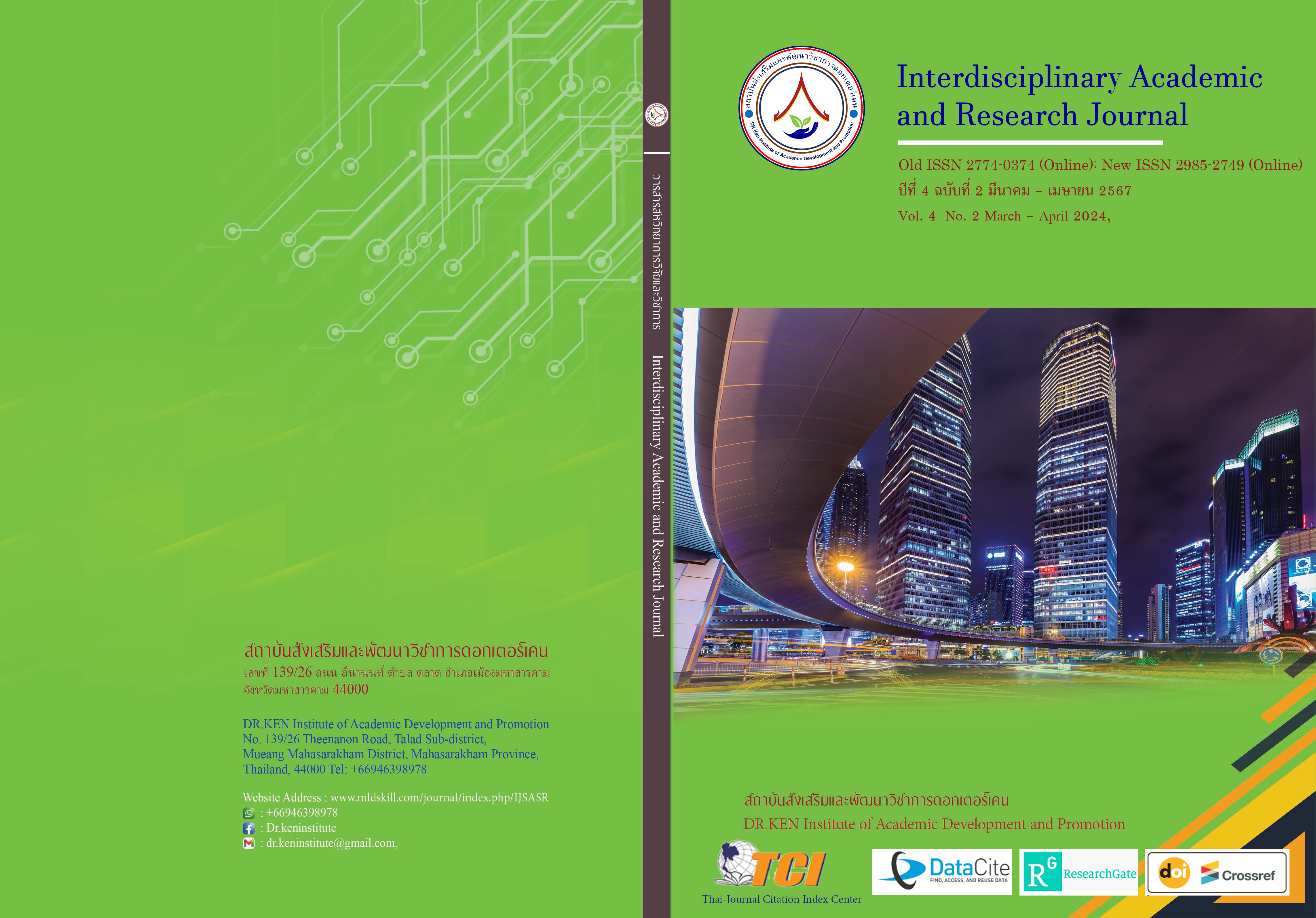Marketing Mix Factors for Service Business and Corporate Image Affecting the Decision to Use Road Freight Services
DOI:
https://doi.org/10.60027/iarj.2024.275003Keywords:
Service Marketing; , Corporate Image; g, Road Freight; , Customer Decision-MakinAbstract
Background and Aims: In an era where competition in the road freight transport service industry is challenging, understanding the marketing mix factors for service businesses and corporate image is essential to attract and retain customers. This research aims to analyze customer opinions and decision-making regarding these factors in the road freight transport business. The objectives of the study are 1) to examine the marketing mix factors for service businesses, corporate image, and decision-making in using road freight transport services, 2) to test the impact of the marketing mix factors for service businesses on decision-making in using road freight transport services, and 3) to test the impact of corporate image on decision-making in using road freight transport services. This research provides insights into factors influencing customer decision-making, crucial for developing marketing strategies and improving services in the road freight transport business.
Methodology: This study focused on road freight transport service users in Thailand, selecting 180 participants using a specific random sampling method. A questionnaire was used to assess user opinions, with content validity (IOC=0.67) and reliability (Cronbach’s Alpha Coefficient=0.59) checked. Data collection concentrated on Bangkok and its vicinity, with sample proportions determined by transport activity density in each area to cover a wide range of businesses using road freight transport services. Descriptive statistics were used for general data and opinion analysis, and multiple regression analysis was employed to find statistically significant relationships between variables at the 0.05 level.
Results: The study found that 1. The service process, marketing promotion, physical characteristics, and corporate image are the primary factors influencing customer decision-making. The corporate image was rated the highest, reflecting its importance in the overall perception and reputation of the corporation. 2. Most factors, such as products, price, location, marketing promotion, staff, and the service process, do not significantly impact the decision to use road freight services, except for the physical characteristics, which are the only factors significantly affecting the decision to use the service. 3. The corporate image does not significantly influence the decision to use road freight services.
Conclusion: The research highlights the importance of service processes and physical characteristics in the road freight transport business. While corporate image plays a key role in creating customer satisfaction and decision-making, other elements of the service business marketing mix factors are less significant compared to physical characteristics in influencing service usage decisions.
References
กรมการขนส่งทางบก. (2567). รายงานการเติบโตของอุตสาหกรรมขนส่งสินค้าทางถนนในประเทศไทย. กรุงเทพฯ:กรมการขนส่งทางบก.
กรมการขนส่งทางบก. (2567). สถิติจำนวนใบอนุญาตประกอบการขนส่งและจำนวนผู้ประกอบการขนส่งทั่วประเทศ. กรุงเทพฯ: กรมการขนส่งทางบก.
กระทรวงคมนาคม. (2567). รายงานการพัฒนาโครงสร้างพื้นฐานขนส่ง. กรุงเทพฯ: กระทรวงคมนาคม.
กิตติศักดิ์ โพธิ์ทอง, ขวัญแก้ว แก้วตา และธเนศ ชูสุวรรณ. (2565). ปัจจัยส่วนประสมทางการตลาดสำหรับธุรกิจบริการที่มีผลต่อการตัดสินใจใช้บริการขนส่งสินค้าทางถนนของผู้บริโภคในเขตกรุงเทพมหานคร. วารสารวิชาการ มหาวิทยาลัยราชภัฏพระนคร, 3(1), 44-52.
ชญาภา จันทร์เพ็ง. (2567). ภาพลักษณ์องค์กรและความภักดีต่อแบรนด์ของผู้บริโภคกลุ่มผลิตภัณฑ์เครื่องสำอางในเขตกรุงเทพมหานคร. วิทยานิพนธ์ปริญญามหาบัณฑิต: มหาวิทยาลัยกรุงเทพ.
ฐาปนี แก้วเสน่ห์ใน. (2564). ปัจจัยที่มีความสัมพันธ์ต่อการตัดสินใจเลือกใช้บริการขนส่งสินค้าแบบด่วนของผู้ใช้บริการในเขตกรุงเทพมหานคร. วิทยานิพนธ์ปริญญามหาบัณฑิต: มหาวิทยาลัยธรรมศาสตร์.
สำนักงานสถิติแห่งชาติ. (2567). รายงานการวิเคราะห์ตลาดขนส่งสินค้าในกรุงเทพมหานคร. กรุงเทพฯ: สำนักงานสถิติแห่งชาติ.
อรุณรัตน์ พรหมไพบูลย์. (2566). ความสัมพันธ์ระหว่างภาพลักษณ์องค์กรกับความพึงพอใจและการตัดสินใจซื้อรถยนต์ไฟฟ้าของผู้บริโภคในเขตกรุงเทพมหานคร. วิทยานิพนธ์ปริญญามหาบัณฑิต: มหาวิทยาลัยอัสสัมชัญ.
Aaker, D.A. (1991). Managing Brand Equity. Free Press.
Bitner, M.J. (1992). Servicescapes: The Impact of Physical Surroundings on Customers and Employees. Journal of Marketing, 56(2), 57-71.
Christopher, M. (2016). Logistics & supply chain management. 5th edition. Pearson UK
Faul, F., Erdfelder, E., Buchner, A., & Lang, A.-G. (2009). Statistical power analyses using G*Power 3.1: Tests for correlation and regression analyses. Behavior Research Methods, 41(4), 1149-1160.
Grönroos, C. (1984). A Service Quality Model and its Marketing Implications. European Journal of Marketing, 18(4), 36-44.
Heskett, J.L., Jones, T.O., Loveman, G.W., Sasser, W.E., Jr., & Schlesinger, L. (1994). Putting the Service-Profit Chain to Work. Harvard Business Review, 72(2), 164-174.
Keller, K.L. (1993). Conceptualizing, measuring, and managing customer-based brand equity. Journal of Marketing, 57(1), 1-16.
Kotler, P., & Armstrong, G. (2020). Principles of Marketing. 17th edition. Pearson.
Kotler, P., & Keller, K. L. (2016). Marketing Management. 15th edition. Pearson Education.
Lovelock, C., & Wirtz, J. (2011). Services Marketing: People, Technology, Strategy. 7th edition. Pearson.
Monroe, K.B. (2003). Pricing: Making Profitable Decisions. New York: McGraw-Hill.
Nunnally, J.C. (1978). Psychometric theory. 2nd edition. New York: McGraw-Hill.
Parasuraman, A., Zeithaml, V.A., & Berry, L.L. (1985). A conceptual model of service quality and its implications for future research. Journal of Marketing, 49(1), 41-50.
Shostack, G.L. (1987). Service Positioning through Structural Change. Journal of Marketing, 51(1), 34-43.
Solomon, M.R. (2009). Consumer Behavior: Buying, Having, and Being. Pearson Education.
Downloads
Published
How to Cite
Issue
Section
License
Copyright (c) 2024 Interdisciplinary Academic and Research Journal

This work is licensed under a Creative Commons Attribution-NonCommercial-NoDerivatives 4.0 International License.
Copyright on any article in the Interdisciplinary Academic and Research Journal is retained by the author(s) under the under the Creative Commons Attribution-NonCommercial-NoDerivatives 4.0 International License. Permission to use text, content, images, etc. of publication. Any user to read, download, copy, distribute, print, search, or link to the full texts of articles, crawl them for indexing, pass them as data to software, or use them for any other lawful purpose. But do not use it for commercial use or with the intent to benefit any business.
















.png)


